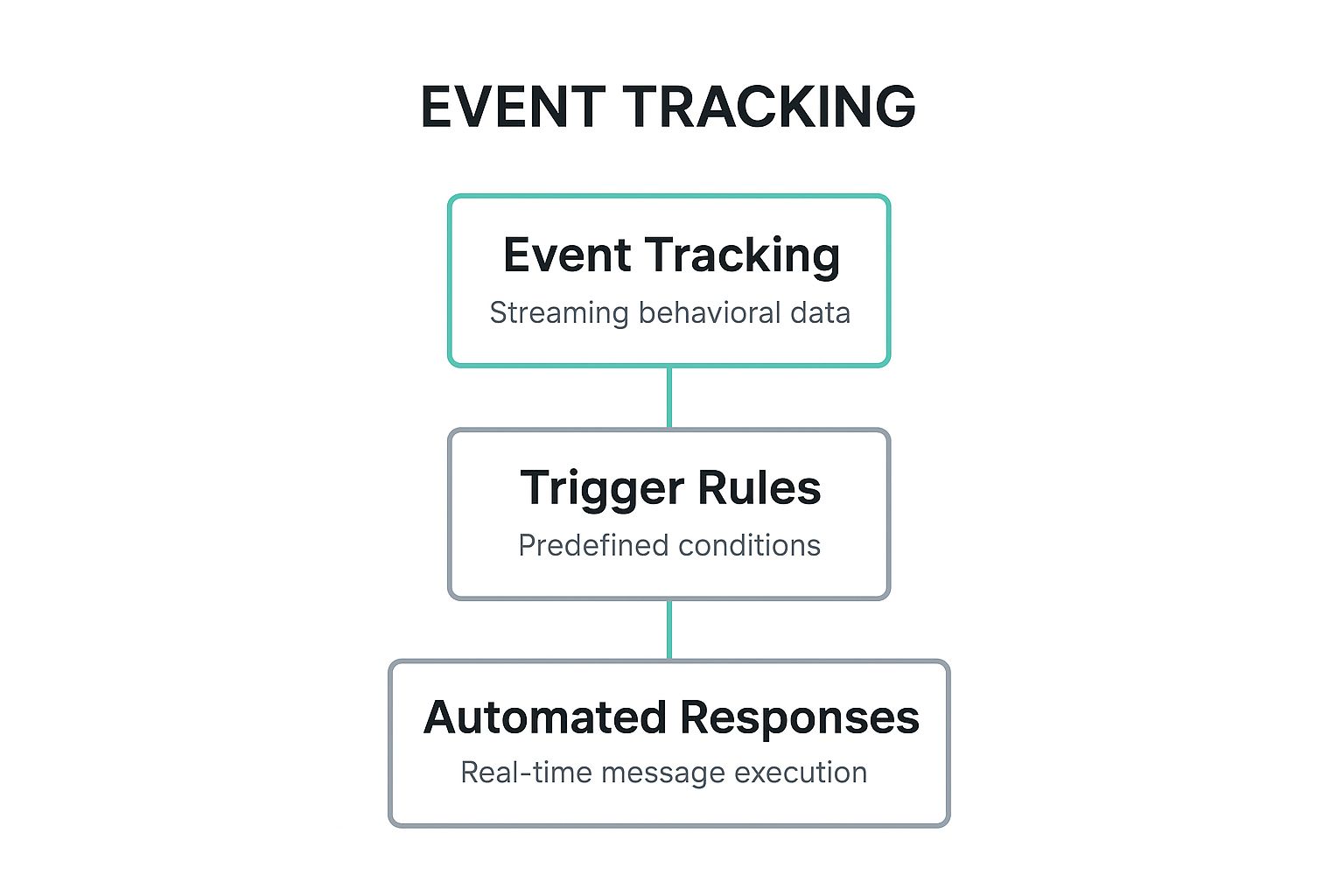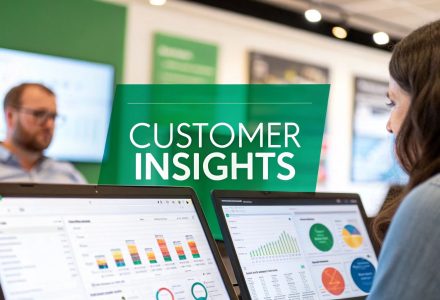Fueling Growth with Data-Driven Insights
Want to significantly boost your marketing ROI in 2025? This listicle reveals eight key data-driven marketing strategies to achieve precisely that. Whether you’re a SaaS company, eCommerce brand, B2B organization, or VC-backed startup, these strategies are crucial for optimizing campaigns and driving growth.
Learn how to leverage customer segmentation, predictive analytics, real-time marketing, attribution modeling, customer lifetime value optimization, lookalike audiences, marketing mix modeling, and A/B testing to achieve scalable results. We’ll provide actionable insights and examples to elevate your data-driven marketing strategy immediately.
1. Customer Segmentation and Personalization
In the realm of data-driven marketing strategies, customer segmentation and personalization reign supreme. This powerful approach hinges on dividing your customer base into distinct groups based on shared characteristics like behavior, demographics, preferences, and purchasing patterns.
By understanding these nuances, you can tailor your content and experiences to resonate deeply with each segment, fostering stronger connections and driving better results. This strategy leverages analytics tools to identify meaningful customer clusters and craft targeted messaging that speaks directly to the needs and desires of specific audience groups, making it a cornerstone of effective data-driven marketing.
This is especially crucial for businesses seeking to optimize their marketing efforts, from SaaS companies driving subscription growth to eCommerce brands boosting conversions.
Understanding Customer Segmentation and Personalization
Customer segmentation and personalization identify patterns by analyzing customer data, creating distinct groups. This process involves:
- Behavioral Data Analysis: Utilizes clustering algorithms to group customers with similar traits.
- Personalization: Dynamic content delivery systems personalize user experiences based on segment characteristics.
- Real-time Engines: Adjust content instantly to ensure relevance and engagement.
Consistency in messaging across all platforms is crucial for a cohesive personalized experience, from email to web content. Automated campaigns, triggered by specific actions, deliver timely messages to nurture leads and boost conversions.
Benefits
The advantages of customer segmentation and personalization include:
- Higher Conversion Rates: Relevant messaging that aligns with individual needs enhances conversion.
- Improved Customer Loyalty: Customers feel understood and valued, boosting satisfaction.
- Resource Efficiency: Better allocation of resources ensures marketing efforts target receptive audiences.
- Increased Lifetime Value: A significant metric for sustainable growth.
Examples of Success
This strategy is successfully implemented by:
- Netflix: Analyzes viewing history for personalized recommendations.
- Amazon: Offers customized product suggestions on its homepage.
- Spotify: Curates playlists based on listening behavior.
- Sephora: Uses its Beauty Insider program for personalized product recommendations.
Challenges
Implementing this strategy involves:
- Data Management: Requires robust data collection and management systems.
- Privacy Concerns: Must address compliance and responsible data handling.
- Complexity: Avoid over-segmentation which may complicate marketing efforts.
Tips for Implementation
For successful implementation:
- Start Simple: Begin with demographic segmentation before diving into complex behavioral data.
- A/B Testing: Validate the effectiveness of messaging for each segment.
- Data Quality: Regular updates and maintaining data accuracy is key.
- Progressive Profiling: Gather data gradually to avoid overwhelming users.
2. Predictive Analytics and Lead Scoring
In today’s data-rich environment, effectively using information is essential for successful data-driven marketing strategies. Predictive analytics and lead scoring enable businesses to anticipate future customer behavior and optimize marketing efforts for greater impact. This strategy uses historical data, machine learning algorithms, and statistical models to identify high-value prospects and predict their likelihood to convert, thereby improving sales efficiency and ROI.
Core Concepts
Predictive analytics and lead scoring analyze past customer interactions, demographics, and other data to identify patterns and predict future actions. It provides insights into which leads are most likely to become paying customers. By assigning scores based on predicted conversion probability, marketing teams can prioritize their efforts on promising opportunities, nurture them effectively, and increase conversion rates.
Features and Applications
The approach includes:
- Machine learning algorithms for pattern recognition
- Lead scoring models based on engagement and firmographic data
- Predictive customer lifetime value calculations
It is also utilized for churn prediction, retention modeling, sales forecasting, and pipeline optimization. For example:
- A SaaS company could identify users likely to churn and implement retention campaigns.
- An eCommerce brand can predict which visitors are likely to purchase and personalize their experience.
Benefits
Predictive analytics and lead scoring provide several advantages:
- Improved Sales Efficiency: By focusing on high-scoring leads, sales teams can close deals faster.
- Better Resource Allocation: Understanding which campaigns and channels drive valuable leads optimizes spending and maximizes returns.
- Proactive Customer Retention: Predict churn and implement targeted interventions.
- Enhanced Sales and Marketing Alignment: Fosters data-driven decision-making and collaboration between teams.
Challenges
Implementing predictive analytics and lead scoring presents challenges:
- Requires access to quality historical data for accurate models.
- Complex implementation and maintenance often require specialized expertise.
- Models need regular updates to prevent becoming outdated.
- Potential for algorithmic bias if training data reflects existing biases.
Successful Implementations
- Salesforce’s Einstein Lead Scoring: Ranks prospects based on conversion likelihood.
- HubSpot’s Predictive Lead Scoring: Uses contact properties and behavior to identify high-potential leads.
- IBM Watson’s Churn Prediction: Helps telecommunications companies address customer attrition.
Practical Tips for Implementation
- Start with simple scoring models and advance to complex algorithms.
- Regularly validate and update models for accuracy.
- Combine implicit and explicit data for better insights.
- Train sales teams on interpreting and using lead scores.
- Continuously monitor model performance and adjust as needed.
Predictive analytics and lead scoring have been popularized by companies like Salesforce, IBM, and Adobe, highlighting their value in data-driven marketing strategies. This tool empowers businesses to anticipate customer behavior, optimize resource allocation, and drive improvements in sales efficiency and ROI, making it a worthwhile investment in the data-driven age.
3. Real-Time Marketing and Behavioral Triggers
Real-time marketing or “RTM” is the process of engaging with customers instantly based on breaking news and information. Real-time marketing and behavioral triggers offer a dynamic approach to data-driven marketing by responding to customer actions with immediate, relevant messages. Using streaming data and automation, businesses can create personalized experiences that boost engagement and conversions.
This data can include website browsing activity, in-app actions, email opens, social media interactions, and even location data. Based on pre-defined rules and triggers, the system automatically executes tailored marketing campaigns.
For example, if a customer abandons their shopping cart, a real-time system can trigger an email reminder within minutes, offering a discount or free shipping to incentivize completion of the purchase. The key is to create a seamless, personalized experience that anticipates customer needs and provides timely, relevant solutions.
The power of real-time marketing lies in its ability to capitalize on fleeting moments of customer interest. By delivering the right message at the right time, businesses can significantly increase engagement rates and drive conversions.
Consider some successful implementations:
- Uber’s surge pricing notifications based on real-time demand allow them to dynamically adjust prices and ensure driver availability.
- Airbnb uses dynamic pricing and instant booking alerts to maximize occupancy and revenue.
- Twitter leverages real-time trend marketing to engage users with trending topics and promote relevant content.
Here are some actionable tips for implementing real-time marketing effectively:
- Define clear trigger rules and response scenarios: Clearly define the specific customer actions that will trigger a marketing response and meticulously outline the corresponding actions.
- Test thoroughly before launching automated campaigns: Rigorous testing is crucial to avoid errors and ensure that the automated responses are accurate and effective.
- Set frequency caps to avoid overwhelming customers: Bombarding customers with too many messages can lead to fatigue and disengagement. Establish frequency limits to prevent over-messaging.
- Monitor performance and adjust triggers based on results: Continuously monitor campaign performance and adjust trigger rules based on data insights to optimize effectiveness.
- Ensure cross-channel consistency in messaging: Maintain consistent messaging across all channels to create a unified and seamless customer experience.
Real-time marketing provides several distinct advantages, including higher engagement rates through timely relevance, improved customer experience and satisfaction, increased conversion rates from immediate response, better customer journey optimization, and a competitive advantage through speed. However, there are also some potential drawbacks to consider.
These include the requirement of a robust technical infrastructure, the risk of over-messaging and customer fatigue, complex integration across multiple channels, potential for errors in automated responses, and potentially high setup and maintenance costs.
The following infographic visualizes the hierarchical structure of real-time marketing, showing the relationship between event tracking, trigger rules, and automated responses.
The infographic highlights the crucial flow of information and actions within a real-time marketing system, emphasizing the top-level importance of accurate and comprehensive event tracking.
By understanding and implementing the principles of real-time marketing and behavioral triggers, businesses can create highly personalized and engaging customer experiences that drive measurable results. This data-driven marketing strategy allows for a dynamic and responsive approach, crucial for success in today’s competitive market.
4. Attribution Modeling and Multi-Touch Analysis
In the realm of data-driven marketing strategies, understanding the true impact of your efforts is paramount. Attribution modeling and multi-touch analysis provide a sophisticated approach to measuring marketing effectiveness, moving beyond simplistic last-click attribution to offer a holistic view of the customer journey.
This strategy allows you to accurately assess the contribution of various marketing touchpoints, enabling smarter budget allocation, optimized campaigns, and ultimately, improved ROI. This makes it an indispensable tool for data-driven marketers seeking to maximize their impact.
Traditional last-click attribution, which assigns all credit to the final interaction before a conversion, fails to capture the influence of earlier touchpoints. Consider a customer who initially discovers your product through a social media ad, later visits your website via organic search, and finally converts after clicking on a retargeting email.
Last-click attribution would solely credit the email, overlooking the crucial role played by the social media ad and organic search in nurturing the customer towards conversion. Multi-touch analysis addresses this limitation by tracking and assigning credit to all touchpoints involved in the customer journey.
Attribution modeling assigns weighted credit to each touchpoint based on a chosen model. Several models exist, each with its own logic and application:
- First-Touch Attribution: Assigns all credit to the first interaction the customer had with your brand. This model is useful for understanding which channels are most effective at driving initial awareness.
- Last-Touch Attribution: Assigns all credit to the last interaction before conversion. While simple, it overlooks the influence of earlier touchpoints.
- Linear Attribution: Distributes credit evenly across all touchpoints in the customer journey. This offers a balanced perspective but may not accurately reflect the varying impact of different channels.
- Time-Decay Attribution: Assigns more credit to touchpoints closer to the conversion, recognizing that interactions closer to the purchase decision are likely to have a stronger influence.
- Algorithmic Attribution (Data-Driven Attribution): Employs statistical modeling and machine learning to determine the optimal weighting for each touchpoint based on historical data. This advanced approach offers the most accurate attribution but requires significant data and analytical expertise.
Features of robust attribution modeling and multi-touch analysis systems include:
- Multi-channel touchpoint tracking and analysis: The ability to track interactions across various channels, including online advertising, social media, email, organic search, and even offline touchpoints.
- Various attribution models: Offering a range of models to suit different business needs and analytical objectives.
- Cross-device and cross-platform journey mapping: Connecting customer interactions across multiple devices and platforms to create a unified view of the customer journey.
- Advanced statistical modeling for attribution weighting (for data-driven models): Leveraging sophisticated algorithms to determine the most accurate attribution weights.
- Integration with marketing mix modeling: Connecting attribution data with marketing mix modeling to understand the overall impact of marketing investments on business outcomes.
Benefits of implementing attribution modeling and multi-touch analysis:
- Better understanding of true marketing ROI: Gain a more accurate understanding of the return on investment for each marketing channel and campaign.
- Improved budget allocation across channels: Optimize budget allocation by shifting resources towards the most effective channels.
- Enhanced customer journey insights: Gain deeper insights into how customers interact with your brand across different touchpoints.
- More accurate performance measurement: Move beyond vanity metrics to measure the true impact of marketing efforts on conversions.
- Data-driven optimization opportunities: Identify opportunities to optimize campaigns and improve overall marketing performance.
Challenges and Considerations:
- Complex implementation and data integration challenges: Integrating data from multiple sources can be complex and require technical expertise.
- Privacy regulations limiting tracking capabilities: Adhering to data privacy regulations can limit the ability to track certain user interactions.
- Difficulty in tracking offline touchpoints: Integrating offline touchpoints into the attribution model can be challenging.
- Requires significant analytical expertise: Advanced attribution models require analytical expertise to interpret results and optimize strategies.
Examples of successful implementation:
- Google Analytics’ multi-channel attribution reports provide a starting point for understanding how different channels contribute to conversions.
- Adobe Analytics’ algorithmic attribution modeling leverages machine learning for more sophisticated attribution analysis.
- Salesforce’s multi-touch revenue attribution is tailored for B2B organizations, focusing on revenue generation.
Tips for successful implementation:
- Start with simpler models like first-touch or last-touch before progressing to more complex models like time-decay or algorithmic attribution.
- Combine multiple attribution approaches to gain a more comprehensive understanding of marketing performance.
- Regularly validate and adjust your attribution model based on changes in your business and marketing landscape.
- Strive to include offline touchpoints in your analysis to capture a more complete picture of the customer journey.
- Focus on actionable insights rather than striving for perfect attribution.
By implementing a robust attribution modeling and multi-touch analysis strategy, businesses can gain a deeper understanding of their marketing performance, optimize budget allocation, and drive significant improvements in ROI. This data-driven approach empowers marketers to make informed decisions based on a comprehensive view of the customer journey, ultimately contributing to sustainable business growth.
5. Customer Lifetime Value Optimization
Customer Lifetime Value (CLV) optimization is a crucial data-driven marketing strategy that focuses on maximizing the total revenue a customer generates throughout their relationship with a business. Instead of chasing short-term gains, CLV optimization prioritizes long-term profitability by nurturing customer relationships and encouraging repeat business.
This approach is particularly relevant in today’s competitive landscape where acquiring new customers is becoming increasingly expensive. By understanding and maximizing CLV, businesses can build a sustainable growth model and ensure efficient allocation of marketing resources. This makes CLV optimization a core component of any comprehensive data-driven marketing strategy.
CLV optimization leverages data analysis and predictive modeling to understand customer behavior and tailor marketing efforts to enhance customer value. It involves segmenting customers based on their predicted CLV, allowing businesses to personalize their interactions and offer targeted promotions. This data-driven approach moves beyond simple transactional metrics and focuses on building long-term, profitable customer relationships.
How CLV Optimization Works:
CLV optimization is a multi-faceted process involving several key steps:
- Data Collection and Integration: Gathering comprehensive customer data from various sources, including CRM systems, marketing automation platforms, and transaction databases, is the foundation. This data provides insights into purchase history, engagement patterns, and demographic information.
- Predictive CLV Modeling: Leveraging historical data, businesses build predictive models to forecast the future value of each customer. These models consider factors like purchase frequency, average order value, and churn probability to estimate the total revenue a customer is likely to generate.
- Customer Segmentation: Based on predicted CLV, customers are segmented into different groups. This allows businesses to tailor marketing strategies to specific customer segments, maximizing the effectiveness of campaigns and promotions. High-value customers might receive personalized offers and premium support, while lower-value customers might be targeted with cost-effective retention strategies.
- Targeted Interventions: Once segmented, businesses implement targeted marketing interventions designed to increase customer value. These interventions can include personalized email campaigns, loyalty programs, exclusive offers, and proactive customer service.
- Performance Measurement and Optimization: Regularly monitoring key CLV metrics, such as customer retention rate, average order value, and customer acquisition cost, is crucial for evaluating the effectiveness of CLV optimization efforts. Models and strategies should be continuously refined based on performance data.
Successful Implementations of CLV Optimization:
Several companies have successfully implemented CLV optimization strategies, demonstrating the power of this approach:
- Amazon Prime: The Prime membership model exemplifies CLV optimization. By offering exclusive benefits like free shipping and access to streaming services, Amazon encourages higher purchase frequency and customer loyalty, ultimately increasing CLV.
- Starbucks Rewards: The Starbucks Rewards program drives both frequency and value by rewarding customers for their purchases. This personalized approach strengthens customer relationships and increases their lifetime value.
- Netflix: Netflix invests heavily in content based on subscriber CLV. By understanding what drives subscriber engagement and retention, they optimize their content library to maximize customer lifetime value.
Actionable Tips for CLV Optimization:
- Start Simple: Begin with basic CLV calculations before implementing complex models. Focus on understanding the core drivers of CLV within your business.
- Segment Strategically: Segment customers based on CLV to target your marketing efforts effectively. Tailor your messaging and offers to resonate with each segment’s specific needs and value.
- Balance Acquisition and Retention: While acquiring new customers is important, focus on retaining existing customers and increasing their value. Retention often yields a higher ROI than acquisition.
- Regular Model Updates: Customer behavior changes over time, so regularly update your CLV models to reflect these changes and ensure accurate predictions.
- Align Incentives: Align organizational incentives with CLV rather than short-term metrics. Encourage a long-term perspective focused on building sustainable customer relationships.
Pros and Cons of CLV Optimization:
Pros:
- Improved long-term profitability and ROI
- Better customer acquisition cost management
- Enhanced customer retention strategies
- More efficient resource allocation
- Sustainable business growth focus
Cons:
- Requires extensive historical customer data
- Complex calculations and modeling requirements
- Long-term strategy that may conflict with short-term goals
- Difficulty in accurately predicting future behavior
- May require significant organizational change
CLV optimization is a powerful data-driven marketing strategy that can significantly impact a business’s long-term success. By understanding and maximizing customer lifetime value, companies can build sustainable growth, improve profitability, and foster stronger customer relationships.
6. Lookalike Audience Modeling: Unlocking New Customer Acquisition Opportunities
Lookalike audience modeling is a powerful data-driven marketing strategy that leverages the power of machine learning to identify and target new prospects who resemble your existing high-value customers.
It’s a smart approach to customer acquisition that allows you to expand your reach and improve your marketing ROI by focusing on individuals most likely to convert. This method is essential for any data-driven marketing strategy seeking to maximize efficiency and growth, earning its place on this list for its potential to significantly impact customer acquisition costs and conversion rates.
How It Works: Mirroring Your Best Customers
At its core, lookalike modeling involves feeding a “seed audience” of your best customers (e.g., highest spenders, most engaged users, repeat purchasers) into a machine learning algorithm. This algorithm analyzes the characteristics, behaviors, and attributes of your seed audience, identifying key patterns and commonalities.
These might include demographics, interests, online behavior, purchase history, and engagement patterns across various platforms.
Once these patterns are identified, the algorithm uses this information to find “lookalikes” – individuals within a larger pool of potential customers who share similar traits with your seed audience. These lookalikes, although not previously engaged with your brand, represent a high-potential segment likely to be receptive to your products or services.
The resulting lookalike audience can then be targeted with tailored marketing campaigns across various channels.
Features that Fuel Success:
Lookalike audience modeling relies on several key features:
- Machine Learning Algorithms: Sophisticated algorithms analyze complex datasets to identify subtle patterns and predict future behavior.
- Integration with Platforms: Seamless integration with advertising platforms (Facebook, Google, LinkedIn, etc.) and databases allows for efficient audience creation and targeting.
- Continuous Refinement: Models are constantly refined based on campaign performance, ensuring ongoing optimization and improved accuracy.
- Multi-Dimensional Analysis: Similarity is assessed across multiple dimensions, providing a more nuanced understanding of customer profiles.
- Scalable Expansion: Lookalike modeling allows for rapid and scalable audience expansion, enabling businesses to reach a larger pool of potential customers.
Real-World Examples:
Several platforms offer lookalike audience modeling capabilities:
- Facebook Lookalike Audiences: Based on custom audiences (e.g., website visitors, customer lists), Facebook identifies users with similar characteristics.
- Google Similar Audiences: This feature allows targeting lookalikes across Google’s display and video networks, leveraging search history, app usage, and website visits.
- LinkedIn Lookalike Audiences: Ideal for B2B targeting, LinkedIn generates lookalikes based on company demographics, job titles, and industry affiliations.
- Pinterest Actalike Audiences: Pinterest leverages engagement data (pins, boards, follows) to identify users with similar interests and purchase intent.
- Custom Lookalike Models: Data management platforms (DMPs) like Adobe Audience Manager and Salesforce DMP offer advanced tools for building custom lookalike models.
Actionable Tips for Effective Lookalike Modeling:
- Start with High-Value Segments: Use your most valuable customer segments as your seed audience. This ensures the model focuses on the most desirable customer profiles.
- Experiment with Similarity Percentages: Platforms often allow you to adjust the similarity percentage of your lookalike audience. A smaller percentage yields a more targeted but smaller audience, while a larger percentage offers broader reach but potentially lower accuracy. Test different percentages to find the optimal balance.
- Refresh Your Source Audience: Regularly update your seed audience to ensure the model reflects current customer behavior and avoids stagnation.
- Combine with Other Targeting Methods: Layer lookalike targeting with other targeting methods (e.g., demographics, interests, keywords) to further refine your audience and improve campaign performance.
- Monitor and Adjust: Continuously track campaign performance and adjust your models based on the results. This iterative process ensures ongoing optimization and maximizes ROI.
Pros and Cons:
While lookalike modeling offers significant advantages, it’s crucial to understand the potential drawbacks:
Pros:
- Higher conversion rates from better-targeted prospects
- Improved customer acquisition efficiency
- Reduced customer acquisition costs
- Scalable growth opportunities
- Data-driven audience expansion
Cons:
- Requires substantial high-quality customer data
- Dependency on platform algorithms and data availability
- Privacy regulations may limit data usage
- Risk of audience saturation over time
- May perpetuate existing customer biases
Lookalike audience modeling is a crucial tool for data-driven marketers looking to expand their reach, improve conversion rates, and optimize their customer acquisition strategies. By understanding the intricacies of this technique and implementing it strategically, businesses can unlock significant growth opportunities and achieve a competitive edge in today’s dynamic market.
7. Marketing Mix Modeling (MMM)
Marketing Mix Modeling (MMM) is a powerful data-driven marketing strategy that provides a holistic understanding of how various marketing activities contribute to sales and business outcomes. Unlike other attribution models that focus on individual customer journeys, MMM takes a broader perspective, quantifying the impact of different marketing channels, campaigns, and external factors on overall performance.
This makes MMM particularly valuable for strategic decision-making, budget allocation, and long-term planning. It allows businesses to understand the effectiveness of their marketing spend across the entire marketing mix, optimizing resources for maximum ROI.
This approach is crucial for data-driven marketing strategies as it moves beyond last-click attribution and provides a comprehensive picture of marketing performance.
MMM, or Marketing Mix Modeling, uses econometric modeling and statistical analysis to understand how marketing investments impact business outcomes. By examining historical data, it identifies the contribution of each marketing channel, considering factors like seasonality, competition, and economic conditions.
This method offers an objective measurement of marketing effectiveness, independent of platform-specific reports, aiding businesses in understanding their marketing ROI. For instance, MMM can compare the effectiveness of TV advertising against digital campaigns, enabling marketers to allocate budgets more effectively. It also quantifies the effects of external factors like economic downturns on sales, aiding in accurate forecasting and strategy adjustments.
Importance in Today’s Marketing
In the current complex marketing environment, businesses invest across various channels, both online and offline. MMM allows marketers to measure the effectiveness of traditional channels such as TV, print, and radio, alongside digital channels like search, social media, and email marketing.
This provides an integrated view of marketing performance, crucial for eCommerce brands seeking to maximize return on ad spend and B2B organizations focused on optimizing lead acquisition and reducing customer churn.
Benefits of MMM
- Integrated View: Offers a complete view of marketing effectiveness across all channels.
- Privacy-Compliant: Provides measurement without relying on cookies or individual data, crucial in a privacy-conscious world.
- Long-Term Planning: Offers insights into the long-term effects of marketing investments, including media saturation and adstock effects.
- Scenario Planning: Enables budget optimization by simulating different allocation scenarios to identify effective strategies for maximizing ROI.
Real-World Application
Companies like Procter & Gamble, Coca-Cola, General Motors, and Unilever use MMM to optimize marketing investments and drive business growth. For example, P&G uses it for global brand investment decisions, while Coca-Cola applies it for marketing mix optimization across various channels.
Limitations
MMM does have limitations. It requires extensive historical data and statistical expertise, making the process time-intensive. The results may lack detailed tactical insights, making it less suitable for short-term campaign optimizations. Additionally, it may not capture individual customer journey insights as it focuses on aggregate data. Combining MMM with other methods, like attribution modeling, can provide a more complete picture.
Key Considerations for Implementation
- Data Quality: Ensure consistent data quality across all channels.
- External Factors: Include external factors that may impact business performance.
- Regular Updates: Update models regularly to reflect market changes.
- Actionable Insights: Focus on actionable recommendations for budget reallocation.
MMM offers a robust framework for data-driven marketing, empowering organizations to make informed decisions about budget allocation, channel optimization, and overall marketing strategy, ultimately driving sustainable growth and maximizing ROI.
8. Advanced A/B Testing and Experimentation
In the field of data-driven marketing, advanced A/B testing and experimentation is a crucial technique for optimization and growth. It extends beyond simple A/B split testing by incorporating methodologies like multivariate testing and sequential testing.
This approach helps businesses refine marketing efforts across all customer touchpoints, improving key performance indicators. It’s especially beneficial for SaaS companies, eCommerce brands, B2B organizations, and startups aiming to maximize marketing ROI and achieve sustainable growth.
Core Concepts of Advanced A/B Testing
- Rigorous Testing: Involves testing different versions of marketing assets (e.g., landing pages, email subject lines) to determine the most effective ones.
- Beyond Basic Testing: Unlike basic A/B testing that compares two versions, advanced techniques include:
- Multivariate Testing: Tests multiple variations at once.
- Multi-Armed Bandit Testing: Dynamically allocates traffic to winning variations as data is collected.
- Efficiency Enhancements: Features like sequential analysis and early stopping allow marketers to monitor results in real-time, stopping experiments early if necessary, saving time and resources. Advanced statistical significance testing ensures result reliability.
Benefits of Advanced A/B Testing
- Encourages data-driven decision-making, reducing reliance on intuition.
- Quantifies the impact of changes, enabling confident resource allocation to effective strategies.
- Leads to improved conversion rates, increased customer engagement, and higher ROI.
Real-World Applications
- Netflix: Uses content and interface testing to personalize user experiences.
- Booking.com: Continuously optimizes its website for maximum conversions and booking value.
- Airbnb: Employs an experimentation framework to refine its platform and improve user acquisition.
Challenges
- Requires significant traffic or sample sizes for statistically significant results.
- May need specialized expertise in statistics and data analysis.
- Can be time-intensive, with risks of testing fatigue and diminishing returns.
- Potential for false positives and statistical errors highlights the importance of a rigorous approach.
Learn more about Advanced A/B Testing and Experimentation
To maximize the effectiveness of advanced A/B testing as a data-driven marketing strategy, consider the following tips:
- Develop clear hypotheses before designing experiments. Define the specific problem you are trying to solve and the expected outcome of each variation.
- Ensure proper statistical power and sample size calculations. This will ensure the reliability of your results.
- Test meaningful changes that could significantly impact metrics. Focus on changes that have a high potential for improvement.
- Document and share learnings across the organization. Create a knowledge base of experiment results to inform future marketing decisions.
- Use experimentation platforms for scalable testing programs. These platforms can automate many aspects of the testing process and provide advanced analytical capabilities.
By embracing these best practices and understanding both the advantages and challenges, businesses can leverage advanced A/B testing to unlock significant improvements in their marketing performance and achieve sustainable growth in today’s competitive landscape.
Companies like Google, a pioneer in large-scale product experimentation, and Optimizely, a leading A/B testing platform provider, have popularized this approach, demonstrating its efficacy as a core component of a data-driven marketing strategy.
Data-Driven Marketing Strategies Comparison
| Strategy | Implementation Complexity 🔄 | Resource Requirements ⚡ | Expected Outcomes 📊 | Ideal Use Cases 💡 | Key Advantages ⭐ |
|---|---|---|---|---|---|
| Customer Segmentation and Personalization | High – data collection, management, tools | High – analytics platforms, real-time engines | Increased conversion, loyalty, CLV | Personalized marketing, targeted campaigns | Better marketing efficiency, relevant messaging |
| Predictive Analytics and Lead Scoring | Very High – advanced ML models, data science | Very High – skilled experts, extensive datasets | Improved sales efficiency, lead prioritization | Sales forecasting, lead management | Data-driven decisions, sales and marketing alignment |
| Real-Time Marketing and Behavioral Triggers | High – robust infrastructure, complex integration | High – automation platforms, streaming data | Higher engagement, immediate response | Time-sensitive offers, triggered campaigns | Competitive speed advantage, contextual relevance |
| Attribution Modeling and Multi-Touch Analysis | Very High – data integration, statistical modeling | High – analytics expertise, multi-channel data | Holistic ROI understanding, budget optimization | Cross-channel performance measurement | Accurate performance measurement, customer journey insights |
| Customer Lifetime Value Optimization | High – predictive modeling, extensive data | High – forecasting tools, segmentation methods | Improved long-term profitability, retention | Long-term growth strategies, loyalty programs | Better ROI focus, efficient resource allocation |
| Lookalike Audience Modeling | Medium-High – machine learning models | Medium-High – customer data, ad platform integration | Higher conversion, scalable acquisition | New customer acquisition, audience expansion | Efficient targeting, data-driven growth |
| Marketing Mix Modeling (MMM) | Very High – econometric/statistical expertise | Very High – historical data, statistical tools | Optimized budget, channel impact clarity | Strategic media planning, multi-channel analysis | Holistic marketing view, privacy-compliant |
| Advanced A/B Testing and Experimentation | High – complex design, statistical rigor | Medium-High – traffic volume, experimentation tools | Continuous optimization, risk reduction | Conversion rate optimization, multichannel testing | Data-driven improvements, scalable experimentation |
Data-Driven Marketing: A Necessity for Success
In today’s competitive landscape, data-driven marketing strategies are essential for businesses aiming to thrive. Whether optimizing subscriptions for SaaS companies, maximizing ROAS for eCommerce brands, generating leads for B2B, or scaling venture-backed startups, insights from data are crucial.
Key Strategies Explored
- Customer Segmentation and Personalization
- Predictive Analytics and Lead Scoring
- Real-Time Marketing and Behavioral Triggers
- Attribution Modeling and Multi-Touch Analysis
- Customer Lifetime Value Optimization
- Lookalike Audience Modeling
- Marketing Mix Modeling (MMM)
- Advanced A/B Testing and Experimentation
Each tactic offers distinct benefits, providing a comprehensive understanding of your customer base and enabling informed decision-making. Mastering these strategies allows businesses to anticipate market changes, personalize customer journeys, and optimize campaigns effectively.
For more insights into how data-driven strategies are shaping marketing, explore the approaches of leading digital marketing startups curated by IndieMerger. These companies are leading the way in developing new technologies and strategies in this dynamic field.
The power of data lies in its ability to drive sustainable growth. By using data-driven insights, businesses can increase conversion rates, reduce churn, enhance customer lifetime value, and strengthen their bottom line. Embrace the potential of data within your organization.
Transform Your Marketing
Ready to enhance your marketing with data? Northpeak helps businesses implement and optimize data-driven strategies for sustainable growth. Visit our site to learn more about achieving your goals.
















